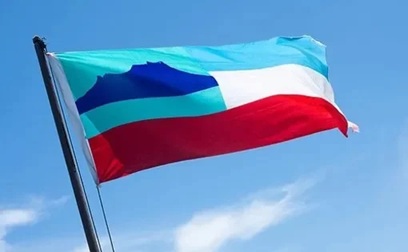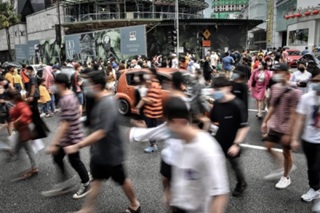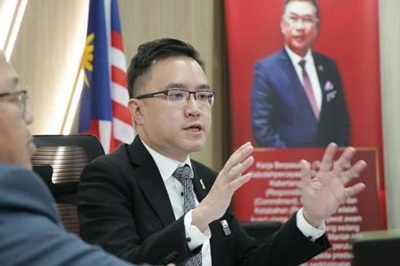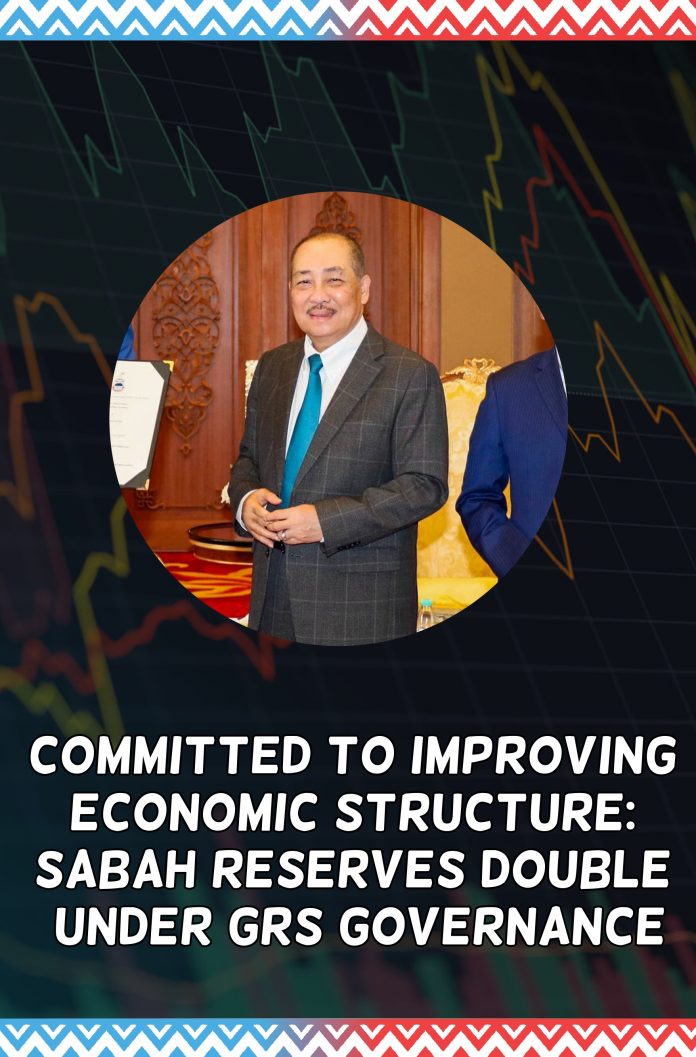The state government’s financial reserves are one of the key indicators in measuring a state’s fiscal management capacity, governance efficiency, and the sustainability of government administration.
Reserves refer to the accumulated funds of the state government derived from various revenue channels such as taxes, royalties, land premiums, forestry income, oil and gas revenue, as well as dividends from government-linked companies (GLCs).
These funds are generally held in cash or highly liquid investments and serve as a fiscal buffer when state revenues decline or in the event of sudden economic shocks, thereby ensuring stability of essential operations. In other words, sufficient reserves help boost investor confidence in local governance and strengthen the state’s economic competitiveness.

In 2019, during the Warisan administration, Sabah’s fiscal position was under strain, with reserves dropping to only RM3.2 billion. In 2020, the global Covid-19 pandemic struck, causing Sabah’s economy to suffer severely, recording a -9.2% contraction. This further exposed the vulnerability of an economy long dependent on primary resource exports.
To break free from dependence on a resource-based economy and to strengthen fiscal resilience, the Gabungan Rakyat Sabah (GRS) government has, since taking office in 2020, implemented a series of structural reforms and prudent fiscal strategies. These efforts have gradually borne fruit. By 2024, state reserves had surged to RM8.6 billion, representing an increase of more than 160% compared with 2019. State revenue also recorded two consecutive all-time highs, RM6.96 billion in 2022 and RM6.973 billion in 2023.
Reserves Rise to RM8.6 Billion – Multiple Dividends
Dr. Saizal Pinjaman, Director of the Centre for Economic and Policy Development at Universiti Malaysia Sabah (UMS), said in an interview with Sun Daily that the growth of state reserves is closely linked to Sabah’s GDP growth, and plays a vital role in safeguarding economic stability.
“Sabah’s economy has long relied on primary commodities such as palm oil and petroleum, where price volatility easily triggers fiscal instability. In this context, a sound reserve system functions as a stabilizing mechanism, ensuring that the state government is still able to carry out operational and developmental responsibilities even when external markets weaken, thus reducing dependence on federal funding.”
He further stressed that the indirect benefits of reserves should not be overlooked. Beyond acting as a fiscal buffer in emergencies, ample reserves also serve as a pool for long-term development funding, allowing the government to invest in industries and projects with high economic multiplier effects. Such investments not only facilitate industrial upgrading, but also stimulate the job market, reduce unemployment pressure, and gradually narrow urban-rural as well as income gaps.
“From RM3.2 billion in 2019 to RM8.6 billion in 2024, this is not just a numerical leap, but also reflects the systemic achievements of the GRS government in fiscal discipline, policy execution, and strategic development coordination.”
According to him, strong reserves enhance the state’s macroeconomic management capacity and, in an era of global uncertainty, serve as a strategic asset to safeguard fiscal independence and policy continuity.

Governance and Transformation Achievements Cannot Be Denied
Datuk Seri Benedict Asing, Political Secretary to Sabah Chief Minister Hajiji Noor and Chairman of Parti Gagasan Rakyat Sabah (Gagasan Rakyat) Penampang Division, said that the doubling of reserves clearly proves the GRS government’s excellence in fiscal governance.
He emphasized that this achievement is the result of years of systematic reforms, optimized revenue and expenditure, and the continuous implementation of economic diversification policies — underscoring the state government’s success in moving away from dependence on traditional resource revenues towards a more sustainable development model.
He revealed that Sabah’s reserves had grown from RM3.2 billion during the Warisan government in 2019 to RM8.6 billion in 2024, an increase of more than 2.5 times, which he described as the direct outcome of the steady implementation of the “Sabah Maju Jaya” (SMJ) development blueprint.
He added that this growth is not merely about numbers, but more importantly, it demonstrates the government’s resolve and consistency in structural reform and policy execution.
He criticized the Warisan government’s underestimation of fiscal pressures, pointing out that state revenue in 2019 was only RM4.2 billion; by contrast, under GRS, state revenue exceeded nearly RM7 billion in both 2022 and 2023. Furthermore, since 2021, Sabah’s economy has consistently recorded positive growth. These figures clearly highlight the stark differences in governance capabilities between the two administrations.

Between 2021 and 2024, the GRS government has continuously driven economic transformation, focusing on reducing reliance on single-resource revenues and pursuing a sustainable development path supported by diverse industries. Leveraging the state’s geographical advantages, rich natural resources, and improving policy environment, the government has prioritized tourism, agriculture and plantations, manufacturing, real estate, and renewable energy — adopting pragmatic and forward-looking strategies.
Industrial diversification has begun to yield results, stabilizing the revenue structure while attracting more domestic and foreign investors. To further consolidate fiscal foundations, the government has also adopted proactive strategies to shift from passive reliance on resource income to active industrial development and investment promotion. In this process, the Ministry of Industrial Development and Entrepreneurship (MIDE) has played a pivotal role as a bridge between policies and markets, as well as between government and businesses.
Infrastructure Upgrades Support Industry Development
Through systematic planning, infrastructure development, and inter-agency coordination, MIDE has successfully attracted numerous domestic and international companies, particularly in the manufacturing, high-tech, and energy sectors — strengthening Sabah’s industrial base while generating sustainable tax revenue and employment opportunities.
In a briefing to the Chief Minister in February, MIDE Permanent Secretary Datuk Thomas disclosed that since September 2020, Sabah’s manufacturing sector had secured RM17.41 billion in approved foreign and domestic investments, involving 73 companies, 52 of which are already operational. These investments have translated into RM7.8 billion in realized capital and over 3,600 jobs. Between 2022 and 2024, Sabah also received RM42.3 billion in new proposed investments, expected to create over 32,000 jobs, including a major RM19.6 billion project by Esteel Group in the Sipitang Oil and Gas Industrial Park (SOGIP).
He further revealed that major corporations such as Kibing Group, Curix, Tex Evolusi Waste Management, and E Concern have chosen Sabah as their base, with MIDE actively facilitating follow-up projects, such as Kibing’s plant in Kimanis, TS Asia Green Infrastructure in Lahad Datu’s Palm Oil Industrial Cluster (POIC), and new proposals from PMB Technology Berhad.

In July this year, Sabah Minister of Industrial Development and Entrepreneurship, Datuk Phoong Jin Zhe, said that in the first quarter of 2025, Sabah secured RM10.9 billion in approved investments, ranking third nationwide, with manufacturing contributing RM7.3 billion. This demonstrates investors’ strong confidence in Sabah.
He also said the state government, through the “State Manufacturing Investment Task Force” platform, is actively addressing investment challenges by working closely with utilities such as water and electricity providers to strengthen infrastructure.
Nonetheless, Phoong emphasized that investment growth requires multi-party collaboration. The state government adheres to the principle of “coordinated planning and parallel development” to ensure that essential public services are not compromised by industrial expansion. Infrastructure upgrades in telecommunications, power, and water supply are ongoing, with the state government also partnering with the Malaysian Communications and Multimedia Commission (MCMC) to enhance network quality — providing crucial support for high-tech projects such as SK Nexilis.
In addition, Kota Kinabalu Industrial Park (KKIP), SOGIP, and Lahad Datu POIC have all received funding for critical facilities. For example, SOGIP is constructing a RM40 million power substation, while POIC is pushing ahead with a seawater desalination project to ensure stable industrial water supply.
Phoong stressed that despite global economic uncertainties and geopolitical challenges, investor confidence in Sabah remains strong. Beyond strong performance in reserves and revenue, the state has also shown robust momentum in attracting investment, diversifying industries, creating jobs, and advancing sustainable development. This demonstrates the government’s active leadership in steering Sabah away from a resource-dependent economy toward an industry-driven model, thereby strengthening fiscal autonomy and paving the way for a brighter future.
VOICE OF ASIA Editorial Note
At VOICE OF ASIA, we believe in amplifying the real voices of the people – especially those too often overlooked in national discourse. This translated article, originally published by Sin Chew, highlights a perspective from Sabah that resonates with our editorial mission: to go beyond headlines and politics, and shine a light on what truly matters to everyday Malaysians.
The original version can be found here.



